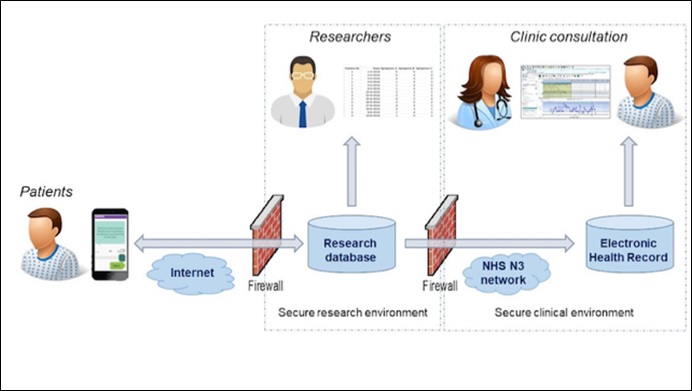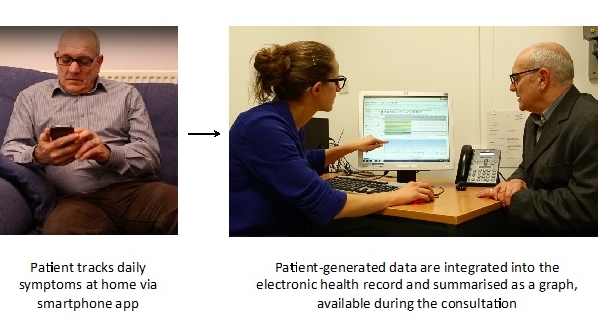Experiences and benefits of working on REMORA
Dr Charlotte Sharp, Clinical Academic Fellow, University of Manchester
As a senior Rheumatology trainee nearing the end of Higher Specialty Training (in other words, I’ve almost reached the peak of the formal clinical hierarchy and qualified as a Consultant), I felt fairly confident that my communication skills were reasonable and that I was able to elicit a clear history from the patients I meet in clinic.
Acting as a clinician researcher on the REmote MOnitoring in Rheumatoid Arthritis (REMORA) study threw that cosy assumption right out of the window. In brief, the study aimed to develop, test and evaluate a smartphone app to remotely monitor symptoms in people living with rheumatoid arthritis (RA). It was my job to see REMORA patients in clinic. Consultations were as close to real life as possible (albeit with the luxury of 30 minutes per patient instead of the usual 15; with tea, biscuits AND grapes free-flowing). You can find out about the objective findings from the study here, but subjectively, it opened my eyes to some of subtleties of the patient-doctor relationship and has changed the way in which I now participate in consultations.
First, it became clear that use of the term ‘flare’ (commonly banded around by patients and clinicians to describe exacerbations of the symptoms of RA) had no unifying definition in clinical practice. Whilst there are formalised methods of attempting to capture flare activity, REMORA clinics highlighted to me not only the mismatch between patients and clinicians on the meaning of the term, but the different meanings applied to the term by different patients, too. This emerged when reviewing patients’ graphs together, where for example, a peak in their pain might be regarded by some and not others as a ‘flare’; and also when reviewing the diary entries of patients and transcripts of recorded interviews and consultations. In order to avoid confusion, I now take care to use the phrase with caution, to qualify what I mean by it, and to seek clarification from patients as to what exactly they mean when they use it.
Second, when asking patients how they’d been (an ‘open question’ which is one of the lynchpins of medical communication skills training), patients frequently reported that they’d been fine, or not had any change in their illness. We’re taught to believe what patients say, so based on this information I would usually do a routine examination, check blood results and be somewhat relieved to have a straightforward consultation, sending the patient merrily on their way, until the next appointment likely 6 months’ later. However, following such a reassuring report from the patient, in the REMORA clinics I was able to interrogate their graphs, which frequently told a different story. ‘What happened here?’ I’d ask. They’d then remember an episode which had been quite debilitating, or realise that their illness had been gradually deteriorating over several months. I might then alter their treatment or suggest another intervention, which may otherwise have been missed.
Example graph 1: Changes in daily reported pain scores over one month

Using the graphs as a prompt demonstrated to me that patients had genuinely forgotten about certain events. In some circumstances, no amount of blind-probing from me was going to help their recall, regardless of how good (or otherwise!) my communication skills were. This is described well in the literature and is understandable as no-one can be expected to remember daily events for 6 months. This allowed me to recognise that patients are fallible too, and that perhaps we all need additional tools to help us understand what is really going on. Until apps such as REMORA become a reality of daily life, I’ll just have to use this insight to ask the most probing questions I can, and live with the hope that one day everyone might have these tools to enhance the quality of their consultations.
Example graph 2: Changes in patient reported perception of coping with RA over one month

Finally, the real game-changer for me was viewing patients’ data together. At last we had shared data that we could discuss, rather than the clinician ‘owning’ the lab results and X-rays, and the patient ‘owning’ the experience, neither of which each party has been particularly good at decoding for the other, historically. We sat together around the computer and patients could quickly understand and explain what the graphs meant to them. Importantly, they physically pointed to the screen (which I moved so they could see it more easily, rather than it being a physical barrier between us). This might seem like a minor point, but for me it symbolised the fact that this was their data, on a platform which was also acceptable and understandable to me. (It seemed to make subsequent explanation of lab results, using similar graphs, much less daunting for them too).
Remote monitoring of any long-term condition which is integrated into a format readily viewable in clinic has a number of benefits, including enhancing the doctor-patient relationship and capturing developments which might otherwise be missed. This is really exciting for the future. However, we face not only the technological challenges of implementing this within an extremely complex NHS context and heterogenous information technology environment, but also the challenges of behaviour change and the risk of clinicians using the data as a proxy for thorough history taking. I look forward to helping to make this type of integration commonplace. Until then, I hope to use the insights gained through working on REMORA to improve the care I offer patients both on an individual basis, and through sharing this learning with colleagues.


REMORA Project have since released a paper on the findings of the study, read more here
Date Published: 29/03/2018